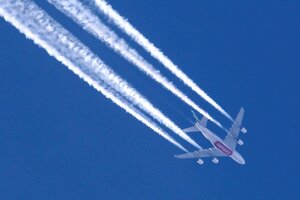Fasten seatbelts, air passengers. Climate change ahead.
Transatlantic flights will be bumpier by 2050 because of rising CO2 emissions, a new study finds. Turbulent episodes could double and the average strength of turbulence would also rise 10 to 40 percent.

An aircraft flies over Frankfurt, Germany, in 2012. A new study suggests climate change could double the chances of airline passengers hitting significant turbulence over the Atlantic by 2050.
Michael Probst/AP/File
LONDON
Turbulence on transatlantic flights will become more frequent and severe by 2050 as carbon dioxide emissions rise, leading to longer journey times and increased fuel consumption, British scientists said in a study on Monday.
Any air traveller has probably experienced turbulence. It can happen without warning and is caused by climate conditions such as atmospheric pressure, jet streams, cold and warm fronts or thunderstorms.
Light turbulence shakes the aircraft, but more severe episodes can injure passengers and cause structural damage to planes, costing around an estimated $150 million a year.
Turbulence will be stronger and occur more often if carbon dioxide emissions double by 2050 as the International Energy Agency forecasts, scientists at the universities of Reading and East Anglia said in the study published in the journal Nature Climate Change.
Carbon dioxide is one of the most potent greenhouse gases blamed for global warming. Increasing emissions raise the global average temperature, heating up the lower atmosphere.
However, warming also changes the atmosphere 10 km above ground level, making it more unstable for planes, Paul Williams at the University of Reading and co-author of the report, told Reuters.
FASTEN YOUR SEATBELTS
The scientists focused on the North Atlantic flight corridor - where 600 planes travel between Europe and North America each day - using computer simulations to examine the effects of climate change on conditions there.
They found that the chances of encountering significant turbulence by the middle of the century will increase by between 40 and 170 percent, with the most likely outcome being a doubling of airspace containing significant turbulence.
The average strength of turbulence would also increase by between 10 and 40 percent.
Bumpier air journeys would make flying more uncomfortable and raise the risks to passengers and crew.
Detours to avoid strong patches of turbulence would lengthen flight times, increasing fuel consumption, emissions and airport delays, which would ultimately drive up ticket prices, Williams said.
Air travel is one of the fastest-growing sources of carbon dioxide emissions, but the effects of climate change on turbulence have not been studied before.
"Aviation is partly responsible for changing the climate in the first place. It is ironic that the climate looks set to exact its revenge by creating a more turbulent atmosphere for flying," Williams said.
The International Air Transport Association said the issue of climate sensitivity still held many uncertainties and the study would not change airline procedures.
The aviation sector is aiming to halve its net CO2 emissions by 2050 from 2005 levels through new technology, alternative fuels and increased efficiency.
There have also been attempts to tax the sector amid slow progress towards a global deal on curbing aviation emissions.
The European Union tried to force all airlines landing or taking off from EU airports to pay for their emissions last year through its carbon trading scheme. But opposition was so fierce it almost led to a trade war, so the law was frozen for a year for inter-continental flights.

